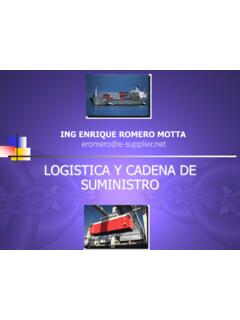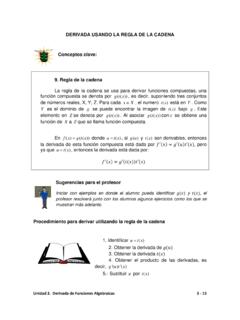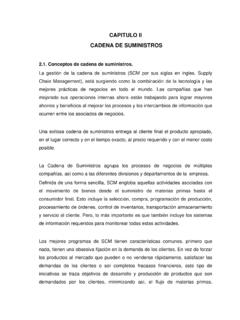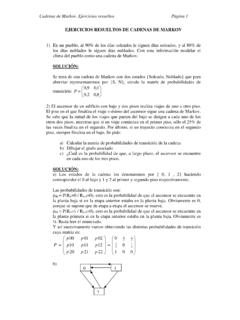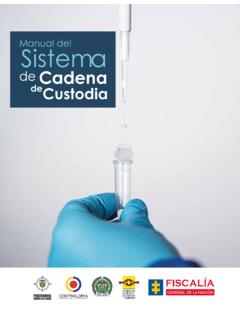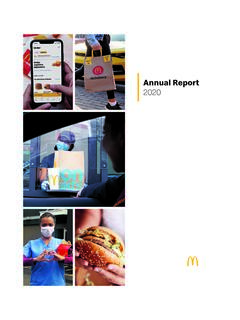Transcription of Agricultural value chain finance
1 Agricultural value chain FinancePraise for this This book makes a useful contribution to the rapidly expanding literature on value chains by clarifying the myriad methods, some old, some new, used to finance actors in Agricultural value chains. Richard L. Meyer, Professor Emeritus, Ohio State University I recommend the publication to be read by all stakeholders in the agriculture sector. Ramana, former CEO, BASIX, India and Chairman, Indian Society of Agribusiness Professionals, India This is a must read for anyone interested in value chain finance . The authors have moved forward our understanding by presenting a conceptual framework, supported by an extensive use of case studies, which makes this book indispensible for those involved in financing as well as policy makers. Kenneth Shwedel, Agricultural economist An insightful and complete analysis of Agricultural value chain financing.
2 An essential reference for anyone interested in improving access to Agricultural credit in developing countries. Mark D. Wenner, Inter-American Development BankAgricultural value chain FinanceTools and LessonsCalvin MillerandLinda JonesPublished by Food and Agriculture Organization of the United NationsandPractical Action Publishing2010 Practical Action Publishing LtdSchumacher Centre for Technology and DevelopmentBourton on Dunsmore, Rugby,Warwickshire, CV23 9QZ, FAO, 2010 ISBN 978 1 85339 702 8 FAO ISBN 978 925 106277 7 All rights reserved. FAO encourages reproduction and dissemination of material in this information product. Non-commercial uses will be authorized free of charge upon request. Reproduction for resale or other commercial purposes, including educational purposes, may incur fees. Applications for permission to reproduce or disseminate FAO copyright materials and all other queries on rights and licences, should be addressed by e-mail to or to the Chief, Publishing Policy and Support Branch, Office of Knowledge Exchange, Research and Extension, FAO, Viale delle Terme di Caracalla, 00153 Rome, catalogue record for this book is available from the British authors have asserted their rights under the Copyright Designs and Patents Act 1988 to be identified as authors of this 1974, Practical Action Publishing (formerly Intermediate Technology Publications and ITDG Publishing) has published and disseminated books and information in support of international development work throughout the world.
3 Practical Action Publishing is a trading name of Practical Action Publishing Ltd (Company Reg. No. 1159018), the wholly owned publishing company of Practical Action. Practical Action Publishing trades only in support of its parent charity objectives and any profits are covenanted back to Practical Action (Charity Reg. No. 247257, Group VAT Registration No. 880 9924 76).The designations employed and the presentation of material in this publication do not imply the expression of any opinion whatsoever on the part of the Food and Agriculture Organization of the United Nations concerning the legal status of any country, territory, city or area of its authorities, or concerning the delimitation of its frontiers or boundaries. The mention of specific companies or products of manufacturers, whether or not these have been patented, does not imply that these have been endorsed or recommended by FAO in preference to others of a similar nature that are not mentioned.
4 The views expressed herein are those of the authors and do not necessarily represent those of photo: Potato conveyor belt FAO/Olivier Thuillier, and authors own photosCover design by Practical Action PublishingIndexed by Andrea PalmerTypeset by Services, New DelhiPrinted by Hobbs the Printers Ltd, Totton, HampshireContentsBoxes viiFigures ixTables xAbout the authors xiAcknowledgments xiiiPreface xv1. Introduction 1 Defining value chain finance 2 Why is there interest in value chain finance in agriculture? 3 Overview of content 32. Understanding Agricultural value chain finance 5 Context 5 The concept of Agricultural value chain finance 8 Agricultural value chain finance as an approach 14 Enabling environment 17 Standards and certification 19 Regulation and enforcement 20 Macro-economic and social context 21 value chains and diversified livelihoods 233. value chain business models 27 Producer-driven value chain models 29 Buyer-driven value chain models 30 Facilitated value chain models 36 Integrated value chain models 40 Case Study 1.
5 Farm Concern International: commercial village approach 454. Agricultural value chain finance instruments 55 Product overview 55 Product financing 55 Trader credit 58 Input supplier credit 60 Marketing company credit 62 Lead firm financing 64 Receivables financing 67 Trade receivables finance 67 Factoring and forfaiting 69vi Agricultural value chain FINANCEP hysical asset collateralization 72 Warehouse receipts 72 Repurchase agreements (repos) 82 Financial lease 83 Risk mitigation products 84 Crop/weather insurance 84 Forward contracting 85 Futures 87 Financial enhancements 89 Securitization 89 Loan guarantees 90 Joint ventures 93 Bringing it together 95 Case Study 2. Producer-driven financing of farm inputs: Niger informal inventory credit 100 Case Study 3. LAFISE Group: integrated financial instruments and value chain services 1085. Innovations 115 value chain innovations 115 Financial innovations 117 Technological innovations 120 Management systems 120 Networks and exchanges 121 Mobile phones and mobile banking 122 Infrastructural innovations 123 Policy and public sector innovations 124 Case Study 4.
6 DrumNet and technological innovations 126 Case Study 5. Integrated agro food parks: avenues for sustainable Agricultural development in India 1376. Lessons learned and summary recommendations 147 Lessons learned 147 Summary of recommendations 153 Recommendations regarding financial institutions 154 Recommendations regarding value chain stakeholders 155 Recommendations regarding policymakers 157 List of conferences 159 References 161 Index value chain definitions Flower chain financing, Mexico Five C s of lending applied to value chain financing Financial flows within the rice industry Cacao producer association, Peru Buyer relationship credit-worthiness, Costa Rica Formal contract agriculture, Philippines Failure of contract farming in tomato production in Brazil Success factors for contract farming Facilitating chain development in Malawi and Tanzania Facilitating artichoke chain development and finance in Peru BRAC integrated services model for agriculture.
7 Bangladesh National Agricultural Cooperative Federation, Korea Small-scale farmer capacity and competitiveness, Kenya Trader finance in Latin America Input supply credit, Myanmar Input supplier credit, Bangladesh Processor finance for agave farmers, Mexico Marketing company finance , Costa Rica Lead firm finance and assistance in Central America Factoring in Serbia Formal agri-fishery warehouse receipts, Philippines Informal warehouse receipts, Tanzania Field warehousing, India Publicly controlled warehouses, Philippines Agricultural warehouse receipts in the wider system, India ACE and global risk mitigation 80viii Agricultural value chain Warehouse receipt challenges and solutions, India Warehousing livestock, Mexico Using futures in price risk management, MCX, India Livestock securitization, BNA, Colombia Public-private contract farming, Thailand Kisan credit cards, India Integrated information management, BASIX, India Electronic network for fruit and vegetable trade, India E-choupal information centres, India Transportation innovation in the Philippines value chain approach to Agricultural services.
8 Costa Rica Agri-export zones in India Warehousing of nomadic farmers honey in northern India Product and financial flows within the value chain Interlinked cereal lending BASIX livelihood services model Different ways to coordinate and structure the value chain Artichoke value chain Rabobank integrated agriculture finance structure Commercial village approach for African traditional vegetables Market access financial service flowchart Pre-export receivables finance basic scheme Pre-export receivables finance scheme HDFC Bank warehouse system SACCO Cooperative warehouse storage Brazil rural finance note finance Para- finance guarantees in Mexico Financing with future receivables value chain financing: shrimp industry model Capturing the agri-food value chain Poverty production cycle Inventory credit flow chart Traditional cost structure in Nicaragua LAFISE Group partner model of intervention LAFISE Group integrated service model A stylized value chain Inter-connected value chains in a subsector The DrumNet actors Process flow A holistic perspective: Agricultural value chain approach 140x Agricultural value chain Integrated Agricultural food park model and activities Customized financial products for edible oil processing value chain stakeholders Non-financial services favouring credit recovery Integrated dairy at IAFP.
9 Information, product and financial flow Farmer-centric ecosystem services 149 Tables Kenyan Government Interlinked Cereal programme Typical organizational models of smallholder production Hortifruti financing models Sales in target sites (March August 2008) Description of Agricultural value chain finance instruments Benefits and limitations of product financing Benefits and disadvantages of receivables financing Benefits and challenges of inventory finance and warehouse receipts Financial lease considerations Summary analysis of Agricultural value chain finance products Price increase gained from inventory credit Performance indicators 135 About the authorsCalvin Miller is an Agricultural economist, with a specialization in rural finance . He is Senior Officer and leader of the Agribusiness and finance Group of Rural Infrastructure and Agro-Industries Division, FAO (Food and Agriculture Organization of the United Nations).
10 During his career he has worked in agriculture and financial development in more than 50 countries, with 15 years of global experience in technical assistance, project management and research in rural and Agricultural development finance and marketing. He gained direct field experience working for 16 years in Latin America in Agricultural and rural finance , Agricultural value chain development and agro-enterprise development. He is also the founder of MicroVest, a private sector social investment fund for microfinance, and a co-founder of the Rural finance Learning Centre, a multi-institutional resource centre managed by FAO. He has published manuals and other documents on Agricultural finance and value chain Jones is an international consultant specializing in inclusive market development and a technical adviser for sub-sector/ value chain development programmes, particularly in agriculture.










